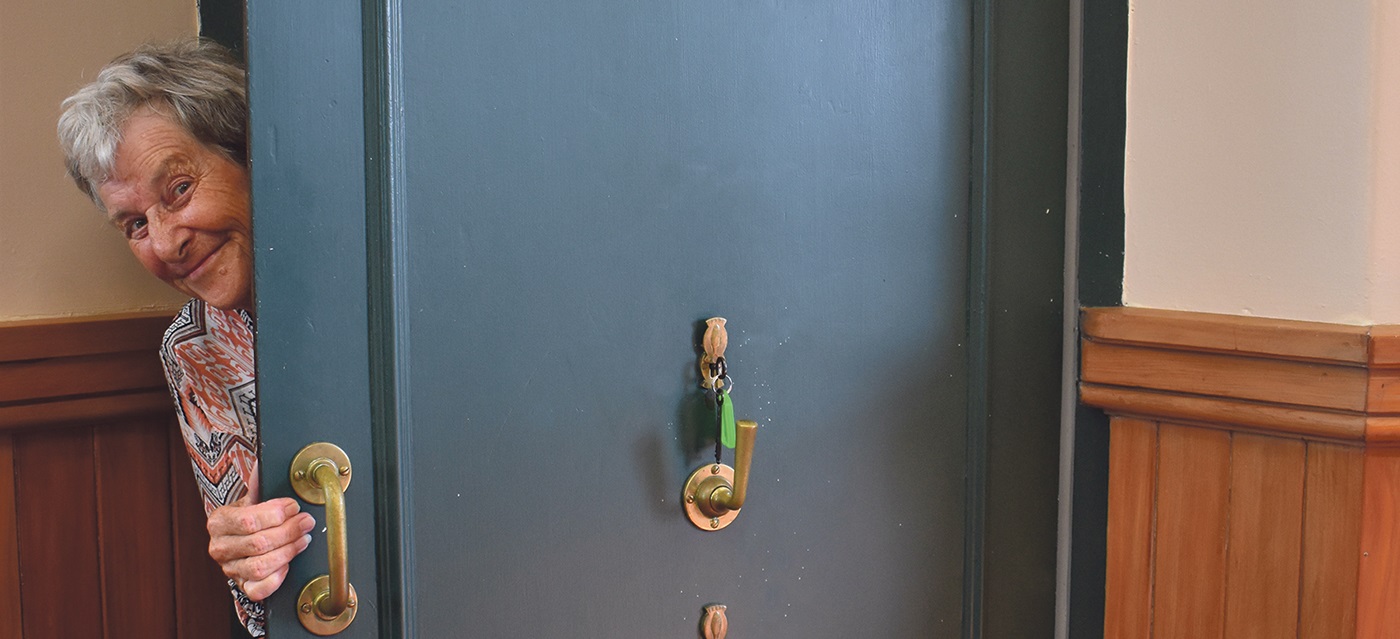
On Wellington Anniversary weekend, January 20-22, nine Kāpiti Coast museums participated in what was called The Kāpiti Heritage Clue Hunt.[1]
The aim of the clue hunt, which is in its second year, is to make a visit to a museum fun and a family-centred experience.

Ōtaki Museum volunteer Chris Greenwood peeks from behind the door of the vault that once protected the cash and important documents held by the Ōtaki branch of the Bank of New Zealand.
Photo Ōtaki Today
Based on the results, it succeeded. There were 2570 visitors to the museums, a 21 percent increase from last year. A total of 69 percent of visitors were from Kāpiti, mostly Paraparaumu and Waikanae, and 28 percent from the greater Wellington region, mainly Wellington City and Lower Hutt.
On average, each visitor went to seven museums. The Ōtaki Museum had 194 visitors during the weekend. Before the clue hunt started, numbers were much smaller – for example, six visited Ōtaki in 2022.
In 2024, the Ōtaki visitors completed 154 clue hunt entries, and out of all of those, only four people wrote down the wrong answer to this question: “What is the type of fish incorporated into the design on the bank vault?”
For anyone who hasn’t visited Ōtaki Museum, it was once the Bank of New Zealand, and the vault remains in what is now the main exhibition space.
The story that leads to the correct answer is an interesting one.
When the museum building opened in 1918 as the Bank of New Zealand, it was fitted with a Chubb Company Strong Room Vault.
A hundred years before the bank opened, Charles and Jeremiah Chubb had started out their working careers as ironmongers in Portsmouth, England. In 1835, the brothers produced and patented their first burglar-resistant Chubb safe. Two years later, the manufacture of locks assumed equal importance with that of the safes.

The chub fish features on the locks for the Ōtaki Museum’s vault door.
Photo supplied
On February 4, 1876, they registered the first trademark, based on a fish – the chub, or squalius cephalus. – that is widespread in lowland England. It can be seen as part of the design on the vault door in the Ōtaki Museum, forming the covers over the locks. And, so, as 150 visitors discovered, “Chub” was the correct answer.
It seems that everyone who took part in the clue hunt enjoyed themselves. Here are a couple of comments:
“We were three generations of family. Started at Paekākāriki and finished at Ōtaki. We had an interesting day and will look at going back and revisiting some of the museums. Mixture of easy and hard-to-find clues, but that added to the puzzle. Thanks for organising a great family event.”
“It was great, we challenged ourselves to do all nine today went from Ōtaki down through to Paekākāriki. So many that we’ve never been to before. Finished with a tram ride and an ice block.”
Next year if, on the Wellington Anniversary weekend, you wish to have fun, especially with your family, and to top off the day with a fruity, melty, cooling ice block, get out and be among the people participating in the clue hunt, and looking for the answer to the question dangling in each of Kāpiti’s nine museums.
OTHER STORIES

